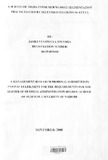| dc.description.abstract | This management project surveyed the consumer market segmentation practices used by
television stations in Kenya. The project was to determine whether TV stations do segment
their customers, and the variables they use as criteria for effective market segmentation to
achieve their objectives. The research design used was descriptive .The population of interest
was all commercial TV stations in Kenya. The sample consisted of this entire population
hence a census study was carried out. Thirteen TV stations were targeted to respond but only
eleven responded. One respondent from each TV station filled the questionnaire. This was
either the Marketing manager or any senior person in the organization who handles marketing
activities.
Primary data was collected using a structured questionnaire that was administered by “drop
and pick” method and email method after prior arrangements. The data collected was
analyzed using descriptive statistical methods like frequencies, percentages, mean scores and
standard deviations. The results were presented by using tables for ease of understanding.
The finding from the study demonstrates that all TV stations in Kenya do segment their
consumer markets (viewers) and this makes them to develop different programmes for
different target audiences. The study also reveals that demographics are the most widely used
segmentation variable in consumer market segmentation.
The study recommends constant monitoring and analysis of various consumer market
segments in order to cope with stiff competition and dynamic unique customers in the media
industry. Similar study can be conducted in print media or in one television station only or in
other countries. This is because the study covered only television stations in Kenya.
There were limitations in the study because most marketing managers were busy in meetings
and sales presentations; therefore some managers were not able to fill the questionnaires. Out
of 13 questionnaires only 11 were filled. Some managers were suspicious because they
thought that the researcher had been contracted to work for competitors, the researcher had to
take time to convince them that the project was only for academic purpose. The combination
of marketing mix and segmentation strategies leads to customer satisfaction. | en |

